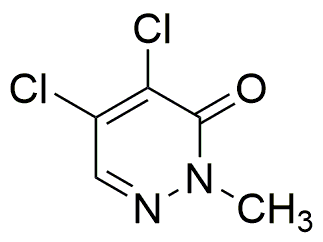4,5-Dichloro-2-methyl-3(2H)-pyridazinone is widely utilized in research focused on:
- Agricultural Chemicals: This compound serves as a key ingredient in herbicides, helping to control unwanted plant growth effectively while minimizing harm to crops.
- Pharmaceutical Development: It is explored for its potential in developing new medications, particularly in targeting specific diseases due to its unique chemical structure.
- Analytical Chemistry: Used as a standard reference material in laboratories, it aids in the calibration of instruments and validation of analytical methods.
- Material Science: This chemical is investigated for its properties in creating advanced materials, contributing to innovations in coatings and polymers.
- Environmental Studies: It plays a role in research assessing the impact of chemical pollutants, helping scientists understand and mitigate environmental risks.
General Information
Properties
Safety and Regulations
Applications
4,5-Dichloro-2-methyl-3(2H)-pyridazinone is widely utilized in research focused on:
- Agricultural Chemicals: This compound serves as a key ingredient in herbicides, helping to control unwanted plant growth effectively while minimizing harm to crops.
- Pharmaceutical Development: It is explored for its potential in developing new medications, particularly in targeting specific diseases due to its unique chemical structure.
- Analytical Chemistry: Used as a standard reference material in laboratories, it aids in the calibration of instruments and validation of analytical methods.
- Material Science: This chemical is investigated for its properties in creating advanced materials, contributing to innovations in coatings and polymers.
- Environmental Studies: It plays a role in research assessing the impact of chemical pollutants, helping scientists understand and mitigate environmental risks.
Documents
Safety Data Sheets (SDS)
The SDS provides comprehensive safety information on handling, storage, and disposal of the product.
Product Specification (PS)
The PS provides a comprehensive breakdown of the product’s properties, including chemical composition, physical state, purity, and storage requirements. It also details acceptable quality ranges and the product's intended applications.
Certificates of Analysis (COA)
Search for Certificates of Analysis (COA) by entering the products Lot Number. Lot and Batch Numbers can be found on a product’s label following the words ‘Lot’ or ‘Batch’.
*Catalog Number
*Lot Number
Certificates Of Origin (COO)
This COO confirms the country where the product was manufactured, and also details the materials and components used in it and whether it is derived from natural, synthetic, or other specific sources. This certificate may be required for customs, trade, and regulatory compliance.
*Catalog Number
*Lot Number
Safety Data Sheets (SDS)
The SDS provides comprehensive safety information on handling, storage, and disposal of the product.
DownloadProduct Specification (PS)
The PS provides a comprehensive breakdown of the product’s properties, including chemical composition, physical state, purity, and storage requirements. It also details acceptable quality ranges and the product's intended applications.
DownloadCertificates of Analysis (COA)
Search for Certificates of Analysis (COA) by entering the products Lot Number. Lot and Batch Numbers can be found on a product’s label following the words ‘Lot’ or ‘Batch’.
*Catalog Number
*Lot Number
Certificates Of Origin (COO)
This COO confirms the country where the product was manufactured, and also details the materials and components used in it and whether it is derived from natural, synthetic, or other specific sources. This certificate may be required for customs, trade, and regulatory compliance.


